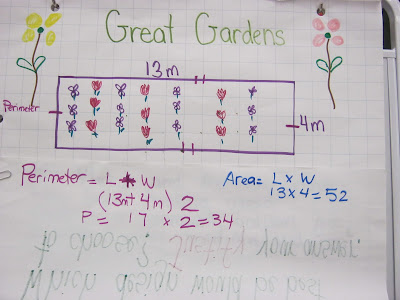For the lesson study in her classroom, she decided to do a lesson on area and perimeter with her students. Here is what she did:
For the minds on, Sarika showed the class this picture and asked them to figure out the area and the perimeter of the garden:
You can see that the class quickly gave her both the formula for area and perimeter and also substituted in the values to help them find the area and the perimeter.
She then gave them this problem for their action:
She worried that the problem was too open for her students. However, as a group we discussed the pros and cons of having a problem so open. The group agreed that in having it as open would be a good way to help the students justify in a way that they felt comfortable with. This also stopped us from seeing a lot of "they should go with this one because its the biggest" type justification.
For the consolidation of the lesson, Sarika originally had decided to do a Bansho with her students. However, as a group, the teachers decided that it would be better for the students to get the time to discuss their thinking and what else needed to go into their answer in order to really help them justify their reasoning as to why they think the garden they chose was the best. Justification is a really hard thing for students to do. They are good at writing " I think they should pick C" but the "because...." is something that they tend to leave out. They are able to do it when you ask them orally, but the stuff that is in their head, does not always make it onto paper.
Here is the work that Sarika's students did. You notice that they did not use the colour black or yellow. This is because yellow is really hard to see, and black becomes the "editing" pen. As you look at the work samples the black writing is what the students added to their work as they were presenting it to the class. This is a great way for the students to see how sometimes just adding a bit more appropriate details really helps to make their answer that much better.
 |
| This group struggled to get going, but really had some great ideas as to why they picked the gardens that they did. It goes to show that students will always surprise you with their thinking! |








No comments:
Post a Comment